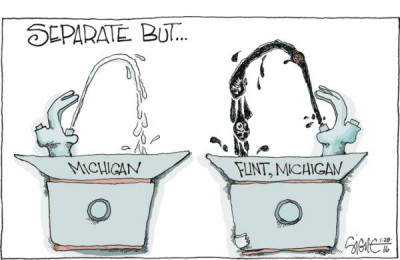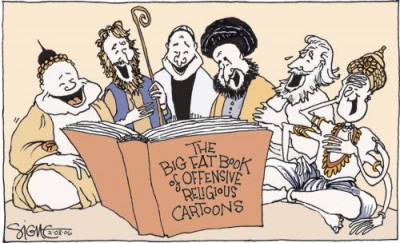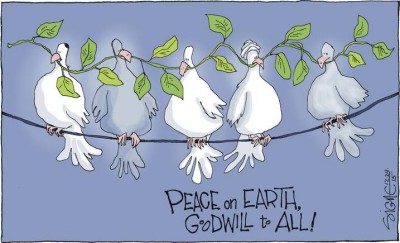An interview with editorial cartoonist Signe Wilkinson
While Philadelphia is not considered the epitome of the bon vivre, it is nonetheless responsible for some goodies we enjoy today, and not just Philly Steak. After all, the Constitution, Ben Franklin and Freedom of the Press got their starts there, as did the Queen of the Philadelphia Daily News, nationally syndicated editorial cartoonist, Signe Wilkinson.

Many cartoonists have told me their most satisfying artistic experience was – one thing or another related to work – getting a first job, seeing their work appear in syndication, even winning a coveted prize – not so with Signe. For her it’s, “the raising of two great daughters.” It’s hard to top that.
Feeling that way about her own kids is one thing; this prolific, first female Pulitzer-prize winning editorial cartoonist (1992) looks back on a less-than supportive childhood. “My own father,” she told us, “was encouraging about art, but ultimately didn’t care what my brothers and I did, as long as it was on our own dime. So I knew I had to make a living.” That living has been a wonderfully successful one, perhaps in part because it WAS so necessary.
Signe had some help from her school days, though. Thanks to the gentle hand of a Miss Brown at General Wayne Jr. High School (Malvern, PA), Signe found her way to Saturday art classes at the Moore College of Art in Philadelphia. “I honestly don’t remember the classes,” she confesses, “but I do remember the thrill of discovering the City.”
It would take a more analytical writer than yours truly to make something of her response to the question as to whether she would share with us a memory from childhood – she merely said, “I could…” and then no more. And to the question as to what would former classmates or teachers say if they could see her now, the Wilkinson answer was, “I spent my life getting away from former classmates.” (As a former teacher, I know how cruel some kids may be.)
 Leaving Signe’s self-censorship behind, we wandered into the area of every-day working censorship. Her answer was enlightening: “After the Danish cartoon controversy, I wanted to draw Mohamed, but my editor, who had backed me up on many controversies, said that this wasn’t our issue (being a local/city paper). I waited two days and figured out how to do it in a way that made my point without maligning an entire religion. I consider this one of my best ‘toons.”
Leaving Signe’s self-censorship behind, we wandered into the area of every-day working censorship. Her answer was enlightening: “After the Danish cartoon controversy, I wanted to draw Mohamed, but my editor, who had backed me up on many controversies, said that this wasn’t our issue (being a local/city paper). I waited two days and figured out how to do it in a way that made my point without maligning an entire religion. I consider this one of my best ‘toons.”
Another ‘toon that Signe recalls with relish is one “with George W. Bush holding up an umbrella for a pregnant woman. But the umbrella only covers her bulging front. She and her already born children are being drenched.”
Considering how very well her editorial cartooning has been received, it’s interesting to find that if she could do something in her career over again, she would have asked for advice from more people?
She does, however, acknowledge the influence of her dear friend, Anne Bertram, “a Quaker born in the 1800’s, who died at 106 and connected me back almost to the the founding of the country. Her aunt grazed cow on the land where my office now sits, and she was the first person who told me what anti-Semitism was and why it was wrong.” (Writer’s note: it’s a pity she didn’t have a larger audience.)
This funny insightful lady had a wonderful answer to my favorite question: if you couldn’t be you, into whose skin would you jump? “Donald Trump. I’d like to find out what it feels like to be a delusional blowhard who makes millions.” She also mused on the possibility of being, “any Black man. Any man. Any musician…okay, not any…maybe Keith Richards. Just to know what being a Rolling Stone feels like…”
Wilkinson didn’t linger long in discussing the internet or the graphic novel except to say the she “wished them well.” And in her assessment of cartooning as a profession, she added ruefully that if an artist hoped to pursue it as a career, “he or she would be disappointed.”
 And in looking down the road, she painted a bleak picture: “Insofar as newspapers have declined, so have editorial cartoons. It’s not where people get their news or views. We’re over. It’ll take the next generation to re-invent.”
And in looking down the road, she painted a bleak picture: “Insofar as newspapers have declined, so have editorial cartoons. It’s not where people get their news or views. We’re over. It’ll take the next generation to re-invent.”
Then she cheered up. “They will,” she says, “and it will be great.”
Even with her almost daily deadlines, Signe still continues her reading habits and would take on a long trip the newest biography of revolutionary Che Guevera, John Lee Anderson’s Che. She had just started it at press time and was “interested in finding out how someone turns to the gun to make societal change.” She also loved and would reread Roz Chast’s Can’t We Talk About Something More Pleasant? and any collection by (fellow Pulitzer winner) Matt Davies.”
Though Signe wonders at the future of her craft, her own brilliance and the response to it (see the daily comments on her blog – her fans are legion and love her), she assures us that, “There will always be satirical art as long as there are little boys and awkward little girls [to comment on them].”
The great movie star, the cranky W.C. Fields, once said, “I once spent a year in Philadelphia. I think it was on a Sunday.” I bet if he’d had the chance to read the brilliant work that Signe Wilkinson cranks out daily, he’d be more than willing to miss the next train to New York.
- Insight on Cartoonists: Michael Capozzola - March 2, 2016
- Insight on Cartoonists: Signe Wilkinson - February 12, 2016
- Insight on Cartoonists: Terry Mosher - January 3, 2016

